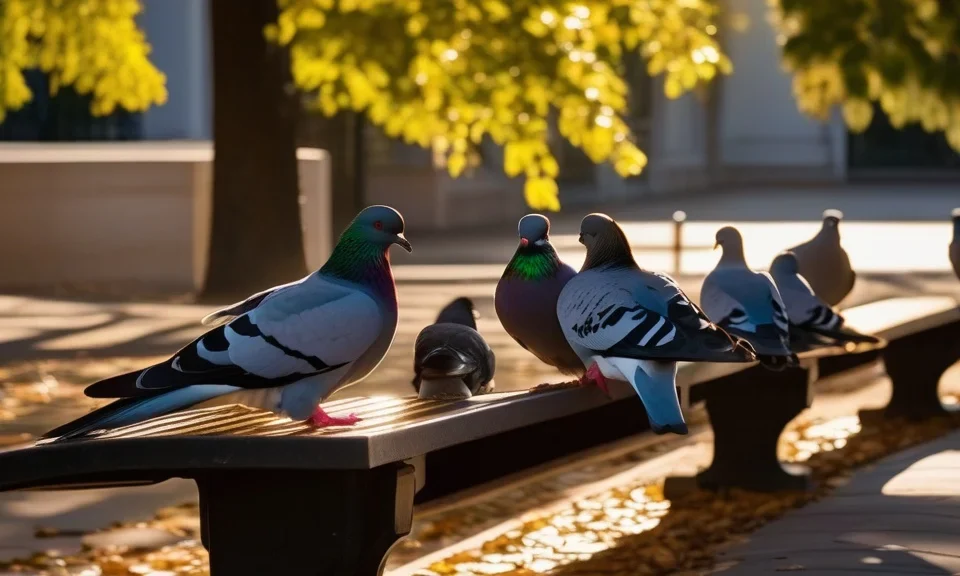Pigeons and Their Unique Nesting Habits
Pigeons are quite the experts when it comes to nesting, displaying behaviors that highlight their adaptability to different environments. They often prefer to build their nests in cozy, sheltered spots that protect them from the elements. You’ll usually find their homes in places like:
- ledges,
- balconies,
- windowsills,
- rooftops,
- eaves,
- attics,
- quieter corners of abandoned buildings.
These locations provide the safety and stability necessary for raising their young ones.
The nest-building journey is a true team effort, with both parents working together over several days to create their haven. Typically, the male pigeon is the one who picks the perfect spot and gathers materials such as:
- twigs,
- straw,
- grass stems,
- leaves.
Together, they craft a small hollow where they can comfortably lay their eggs. As time passes, they often enhance their nest with additional materials, resulting in a more robust and cozy structure.
The nesting process not only demonstrates the ingenuity of pigeons but also highlights their ability to thrive in urban settings while sticking to their natural nesting instincts.
What Are Common Nesting Sites for Pigeons?
Pigeons have a knack for finding suitable nesting spots, showing off their impressive adaptability. They often select familiar locations that offer protection from the elements. Here are some typical places you might stumble upon their nests:
- Building ledges: these flat surfaces on buildings serve as safe havens for pigeons to build their homes,
- Balconies and windowsills: not only do these areas provide shelter, but they also keep the birds close to food sources,
- Roofs and eaves: elevated spots like these create a barrier against predators and harsh weather,
- Attics: the dark, secluded corners of buildings make perfect nesting spots for pigeons,
- Steeples and decorative trims: unique architectural features create cozy nooks ideal for nesting,
- Rafters: the high beams in various structures not only ensure safety but also provide stable surfaces for constructing nests,
- Under bridges or overpasses: these sheltered areas protect the birds from wind and rain, offering a secure environment for raising their young.
Interestingly, pigeons sometimes choose ground-floor corners in abandoned buildings as nesting sites. Ultimately, their main goal is to find a location that offers adequate shelter from harsh weather.
How Do Pigeons Adapt to Urban Nesting?
Pigeons display impressive adaptability when it comes to nesting in urban environments. In cityscapes, they often gravitate towards man-made structures that mimic their natural rocky habitats. Common nesting spots include:
- building ledges,
- rooftops,
- balconies.
These locations provide the elevation and protection necessary to keep them safe from predators.
One of the reasons they thrive in urban settings has to do with their preference for high and sheltered locations that shield them from rough weather. For example, nesting on window sills or beneath eaves allows them to stay hidden while conveniently accessing nearby food sources.
Plus, pigeons have developed behaviors that boost their nesting success in busy city life. They typically choose quieter areas with minimal human disturbances for added safety. On top of that, they’re quick to adapt their nest-building techniques by incorporating materials like:
- twigs,
- leaves,
- items discarded by people.
This ability to adapt not only helps ensure the safety of their young but also demonstrates how pigeons continue to thrive despite the challenges posed by urbanization.
What Role Does the Male Pigeon Play in Nest Selection?
The male pigeon plays an essential role in selecting a nesting site, a decision that can significantly influence the whole nesting process. His main job is to scout out a safe and comfortable location for their future offspring. Once he finds the ideal spot, he starts gathering materials to build the nest, collecting twigs and leaves and transporting them one by one.
While he focuses on picking the perfect site and gathering materials, the female pigeon takes charge of arranging these items into a warm and inviting nest. This teamwork is key; it not only creates a secure environment but also improves their chances of successfully raising their young.
This division of labor highlights their courtship behaviors and strengthens their bond. The collaboration between male and female pigeons during this phase illustrates their adaptability, enabling them to care for their young even in urban settings where good nesting locations can be hard to find.
Observing Pigeon Behavior and Nesting Patterns
Pigeons show unique behaviors when choosing their nesting sites, prioritizing safety and convenience. They tend to prefer locations that shield them from harsh weather and potential predators. You’ll often catch them on flat surfaces like ledges and rooftops, where they enjoy a stable environment.
Building a pigeon nest is pretty straightforward. Using readily available materials like:
- twigs,
- grass stems,
- leaves.
they create a small hollow for securely laying eggs. While these nests might not be tightly packed, this loose structure permits airflow while providing some insulation.
Moreover, pigeons have shown remarkable adaptability to urban environments. They seek out areas that resemble their natural habitats, allowing them to remain concealed while staying close to food sources. Typically, their nests are tucked away in sheltered spots to minimize disruptions from humans and other threats.
When you observe pigeon behavior, you’ll uncover fascinating insights into their nesting habits and adaptability across various environments. Their ability to thrive in diverse settings showcases both their resilience and ingenuity in finding safe breeding grounds.
How Do Pigeons Choose Nest Locations?
Pigeons are quite selective about their nesting sites, opting for places that provide safety, easy access, and proximity to food. They prefer flat surfaces that offer shelter from harsh weather and potential predators. In cities, their nests are often found on ledges, rooftops, or balconies—these spots deliver the protection and stability they seek.
Their choice of nesting locations is strategic; pigeons usually pick elevated areas to keep themselves safe from ground-level dangers. They also tend to build nests near food sources, making it easier to nourish their young ones. This adaptability illustrates how well these birds have adjusted to urban life, especially since natural nesting options can be scarce in such environments.
Additionally, pigeons favor nesting in quieter spots that minimize human interference while ensuring the safety of their chicks. Their ability to flourish in bustling city settings highlights not only their resilience but also their resourcefulness in overcoming challenges presented by urban living.
What Are the Characteristics of a Pigeon Nest?
Pigeon nests are cleverly crafted, providing a secure space for laying eggs and nurturing their young. At the heart of these nests lies a small depression where the eggs are carefully placed, shielding them from potential predators and unpredictable weather. Surrounding this central hollow, pigeons gather a mix of materials such as:
- twigs,
- grass stems,
- straw,
- leaves,
- roots,
- pine needles.
This combination not only offers insulation but also reinforces the nest’s structure.
As pigeons often reuse the same nesting sites for multiple broods, they typically accumulate extra materials over time. This habit can lead to nests turning into sizable mounds filled with various debris with each new breeding cycle. The quality of these nests significantly impacts their breeding success, so pigeons invest plenty of time in building and maintaining a safe haven for their little ones.
Additionally, the loosely arranged materials promote air circulation while still providing necessary warmth. This balance is particularly vital in urban settings where temperature shifts can be extreme. Overall, pigeon nests exemplify an adaptive strategy that showcases the resilience of this species in a range of environments.
Understanding Pigeon Nest Construction
Pigeons showcase a remarkable sense of teamwork when it comes to building their nests, emphasizing their ability to adapt to various environments. The process generally begins with the male pigeon selecting an ideal location, which could be anything from a ledge to a rooftop. Once he has settled on a spot, he gathers the necessary materials for nest building.
The female pigeon plays an equally crucial role in this cooperative effort. She takes over the task of arranging the collected items into a well-structured nest. This partnership is vital for ensuring safety and comfort for their future chicks. Generally, the nest takes about three to four days to complete, with most of the activity happening in the mornings.
Initially, pigeon nests are quite simple and organized, constructed from:
- twigs,
- grass stems,
- leaves,
- and sometimes even discarded human debris.
However, as pigeons often return to reuse their nests for multiple broods, they continuously add new materials. This accumulation not only enlarges the nest but also boosts its insulation and offers better protection from harsh weather and potential threats.
The nesting behaviors of pigeons reflect their ingenuity and adaptability in urban landscapes, where they manage to thrive despite the challenges posed by human presence. Their skill in creating sturdy nests is a testament to their ability to provide a safe space for raising their young effectively.
How Do Pigeons Build Their Nests?
Pigeons work together in building their homes, with both male and female birds contributing significantly. The male typically kicks off the process by scouting a safe location, such as a ledge or rooftop, which offers protection from predators and harsh weather. Once he’s found the perfect spot, he gathers various materials essential for construction.
The entire nest-building endeavor generally unfolds over three to four days, primarily during the mornings. These clever birds utilize:
- twigs,
- grass stems,
- leaves,
- bits of litter they find in urban settings.
Initially, their nests appear neat and well-organized; however, as they reuse these structures for several broods over time, they tend to accumulate additional materials. This not only enlarges the nest but also enhances its insulation.
At the center of a pigeon nest lies a small depression designed to cradle the eggs securely while protecting them from external elements. Interestingly, droppings can also help reinforce the nest’s structure as time passes.
Ultimately, pigeons showcase remarkable adaptability and ingenuity in urban environments through their nesting habits. They create secure havens for their young while making the most of readily available resources.
What Materials Are Used in Pigeon Nest Construction?
Pigeons are resourceful builders, gathering a variety of materials to create cozy nests that offer a safe space for their eggs and chicks. Here’s a closer look at some typical components they use:
- Twigs: these sturdy pieces form the framework, providing essential support for the nest,
- Straw: this lightweight material acts as insulation, keeping the interior snug and warm,
- Grass stems: flexible and soft, grass stems are easy for pigeons to manipulate during construction,
- Roots: strong roots add extra stability, reinforcing the nest’s overall structure,
- Pine needles: the sharp points of these needles can help deter predators while adding warmth,
- Leaves: soft leaves contribute to a comfortable lining within the nest.
Typically, it’s the male pigeons who gather these various materials, while their female partners skillfully arrange them into a secure hollow space ideal for egg-laying. This collaboration is crucial for creating a nest that balances both safety and comfort. Over time, these structures may be further enhanced with additional materials, leading to larger nests that significantly boost breeding success and overall quality.
How Long Does Nest Building Take?
Building a nest is an important task for pigeons, usually taking around three to four days. During this period, the male pigeon plays a key role by gathering essential materials such as:
- twigs,
- grass stems,
- leaves.
Meanwhile, the female meticulously arranges these collected items into a cozy and secure nest for their future eggs.
This collaborative effort is vital for safeguarding their offspring. While the nest might appear tidy at first, it gradually becomes more robust as they incorporate additional materials. This not only enhances its insulation but also fortifies the structure against external threats and harsh conditions. The nesting process beautifully illustrates how adaptable and resourceful pigeons can be, particularly in urban environments where finding appropriate nesting locations can be quite challenging.
Pigeon Breeding and Care of Young
Breeding pigeons is a meticulous endeavor that requires dedicated care for their offspring, known as squabs. The process of incubation begins with the laying of the second egg and lasts around 18 days. Throughout this period, both mother and father take turns keeping the eggs warm and secure.
Once the eggs hatch, the parents come together in nurturing their squabs. Initially, they provide a unique substance called “pigeon milk”, which they regurgitate from their crops. This nutrient-rich fluid plays a crucial role in the early development of the squabs. As these young birds gain strength over the next few days, they start to transition to solid foods like seeds.
Parenting extends well beyond just feeding; it also involves sharing brooding responsibilities. Generally, the male takes charge during daylight hours while the female assumes her role at night. This collaborative approach ensures that their young remain warm and safeguarded.
Squabs usually leave their nest—a phase known as fledging—between 25 and 32 days after hatching. The timing can vary based on factors such as seasonal changes and food availability. Their joint efforts significantly enhance the survival rates of these young pigeons across different environments.
What Is the Incubation and Nestling Period?
Breeding pigeons marks a vital time for their young, particularly during the incubation and nestling stages. Incubation begins with the laying of the second egg and lasts for around 18 days. Throughout this period, both the male and female take turns keeping the eggs warm and protected from potential threats.
Once they hatch, the young pigeons—commonly referred to as squabs—are nurtured by their parents through a collaborative feeding approach. Initially, these little ones are fed “pigeon milk,” a rich substance produced by both adults. As they grow stronger in the following days, they start to sample solid foods like seeds.
The nestling phase concludes when squabs fledge or leave their nest, which usually occurs between 25 to 32 days post-hatching. However, this timeline can vary based on factors such as:
- food supply,
- environmental conditions.
The attentive care provided by their parents during these critical phases significantly enhances the survival odds of young pigeons across various habitats.
How Do Pigeon Parents Care for Their Eggs and Chicks?
Pigeon parents form a solid team in raising their young. They put in a lot of effort to care for their eggs and chicks, which significantly boosts the chances of survival for their offspring. The incubation phase kicks off after the second egg is laid, lasting approximately 18 days. During this time, both the male and female take turns ensuring the eggs stay warm.
When the chicks emerge, they’re known as squabs. Their initial meals consist of “pigeon milk,” a nourishing substance created by both parents who regurgitate food from their crops. This unique feeding method delivers essential nutrients that are vital for their early development. As squabs grow—typically within just a week—they start to transition to solid foods like seeds. By around day nine, they begin to enjoy more adult-like food options.
Besides feeding, pigeon parents also share the responsibility of brooding. Usually, the male keeps watch over the nest during daylight hours while the female takes her turn at night. This teamwork not only ensures that the chicks remain warm but also provides ongoing protection from potential threats.
This collaborative approach to parenting significantly enhances chick survival rates across different environments.
Challenges and Adaptations in Pigeon Nesting
Pigeons face numerous challenges when it comes to nesting, particularly in urban environments. One major concern is the practice of reusing nests, which can accumulate parasites and debris over time. Older nests often contain droppings that might pose a risk to their chicks. Nevertheless, many pigeons still prefer these familiar structures because they provide essential protection against environmental hazards.
To combat these risks, pigeons have developed several clever strategies for safeguarding their nests:
- selecting high places such as building ledges or rooftops,
- creating a natural barrier against predators,
- shielding themselves from dangers lurking below,
- protecting their young from threats that may come from above.
Additionally, pigeons exhibit increased caution in their nesting habits due to the challenges presented by city life. They typically seek out quieter spots with minimal human interference, allowing them to nurture their chicks in a safer setting. Over time, these birds have become adept at navigating urban landscapes while staying true to their instincts for safety and shelter.
By wisely reusing nests and choosing strategic sites, pigeons showcase incredible adaptability and resilience as they tackle the various threats encountered during nesting in metropolitan areas.
What Are the Risks of Nest Reuse?
Reusing nests presents various challenges for pigeons. One significant issue is the accumulation of parasites and debris in older structures. As these nests age, they can become a magnet for pests that threaten both adult birds and their young. Moreover, the buildup of droppings poses serious health risks to fledglings, potentially leading to diseases that could jeopardize their survival.
Despite these dangers, pigeons frequently opt for familiar nests. This decision offers crucial protection against environmental threats such as predators and harsh weather conditions. Their choice reflects an important compromise: prioritizing the immediate safety provided by established nests while being aware of the health risks involved.
In urban settings, pigeons demonstrate remarkable adaptability, which affects their nesting preferences. They often choose elevated spots like building ledges or rooftops that naturally afford some level of shelter. Simultaneously, they seek out previously occupied nests for extra security. This behavior illustrates how pigeons navigate the delicate balance between safety and health risks when selecting nesting sites in cities, underscoring their resilience in overcoming obstacles.
How Do Pigeons Protect Their Nests from Predators?
Pigeons employ various clever strategies to safeguard their nests from predators. A key approach involves selecting elevated spots that are difficult for ground-based threats to access. These birds often opt for ledges, rooftops, and other high surfaces, which naturally offer them some degree of protection.
Furthermore, pigeons exhibit a keen awareness around their nesting sites. They are not shy about defending their territory; in fact, they can be quite aggressive towards any intruders that wander too close. This vigilant behavior plays a crucial role in keeping their eggs and chicks safe from dangers such as birds of prey and other potential threats.
Additionally, the construction of their nests contributes significantly to their safety. By choosing concealed locations—like attics or secluded corners—they minimize the chances of being spotted by predators. Their nests are typically made from materials such as twigs and leaves, arranged loosely to ensure proper airflow while still providing warmth and insulation.
Through strategic site selection, proactive defense mechanisms, and thoughtful nest-building techniques, pigeons demonstrate remarkable adaptability in protecting their young from harm.
How Have Pigeons Adapted to Urban Threats?
Pigeons have shown outstanding adaptability when it comes to navigating the challenges of urban environments, using various strategies to flourish in city life. One notable adaptation is their preference for nesting in elevated, secure spots such as:
- building ledges,
- rooftops,
- balconies.
These high locations not only shield them from inclement weather but also protect against ground-dwelling predators.
Beyond choosing strategic nesting sites, pigeons exhibit caution to enhance their survival odds. They often gravitate toward quieter areas with minimal human presence, allowing them to raise their young without undue disturbances. This inclination for more secluded habitats ensures they can care for their chicks while remaining vigilant for potential threats.
Moreover, pigeons cleverly utilize man-made structures that mimic their natural surroundings. By scavenging materials found in the urban landscape—such as:
- twigs,
- various discarded objects,
- recyclable materials.
They create nests that are both functional and safe. Their knack for adapting nesting methods according to environmental conditions highlights their resilience and ingenuity in tackling the hurdles of city life.
In essence, the ways in which pigeons adapt to urban challenges blend instinctive behaviors with learned experiences. This flexibility enables them to thrive amidst the complexities of metropolitan living. Understanding how wildlife coexists with human development enriches our appreciation of these fascinating birds.









